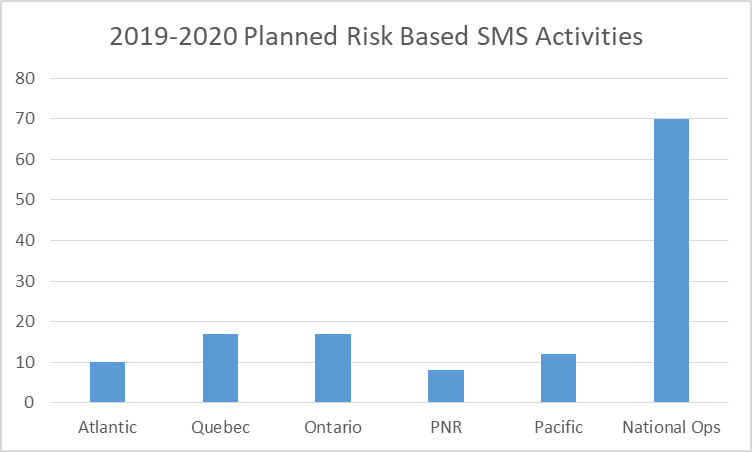This page presents an overview of Safety Management System (SMS) related Oversight Activities conducted by Transport Canada Civil Aviation during the 2019-2020 fiscal year.
On this page
- Background
- Oversight Cycle
- SMS oversight activities results and statistics for 2019-2020
- Most common observations (trends)
- Conclusion
- Organizational contact information
Background
A safety management system (SMSFootnote 1) is a formal framework for managing risk. It helps companies manage safety by requiring them to:
- identify safety concerns, assess the risks they represent, and reduce those risks as needed
- set goals to improve safety and measure whether they meet those goals
- develop procedures for employees to report safety hazards, and a policy that protects employees who report to the safety management system
- make sure employees are trained and able to do their jobs
- implement a quality assurance program
- regularly review the safety management system to make sure it’s working effectively.
Transport Canada lets companies tailor their safety management systems to meet their unique operating needs within guidelines explained in the regulations.
In Canada, SMS is in place for:
- CAR 705 Airline Operations
- CAR 573 Approved Maintenance Organizations for CAR 705
- CAR 302 Certified Aerodromes
- CAR 805 Air Navigations Services
- CAR 604 Private Operators
Safety management systems aren’t required for:
- commuter organizations
- air taxi organizations
- aerial work organizations
- other approved maintenance organizations
- flight training units
- approved manufacturers
- aeronautical product certification organizations
Oversight Cycle
Transport Canada Civil Aviation (TCCA) plans which aviation companies we will inspect by assessing risk. We’ve grouped companies based on their highest certificate type(s) so that we can compare safety risk indicators.
If a company has high risk indicators compared to its peers, we add it to the National Oversight Plan. This means that we will inspect the company during the fiscal year.
We grouped safety risk indicators into two risk-based tiers: quantitative and qualitative.
| Quantitative (data based on numbers) risk indicators | Qualitative (data based on experience) risk indicators |
|---|---|
|
Time since last inspection |
Based on a questionnaire completed by the TCCA Inspectors responsible for each company |
|
Number of findings (during or since) last inspection |
|
|
Number of CADORS in a given period |
The default type of planned inspection is a process inspection. Process inspections allow inspectors to look at a company’s processes to see if they:
- are effective
- consistently reach their goals
- result in regulatory compliance
Healthy processes provide confidence that the systems they support are also effective. On the other hand, a process that doesn’t consistently achieve compliant results can point to a problem with the whole system. This is how process inspections can help identify systemic breakdowns.
Process inspections may or may not evaluate SMS processes, depending on the certificate type, whether the company has SMS, and the scope of the inspection.
Where results of a process inspection point to systemic issues, we use reactive surveillance to explore and deal with those concerns. Reactive surveillance includes all inspection activities that aren’t in the National Oversight Plan, including:
- targeted inspections
- compliance inspections
- process inspections
- program validation inspections
- safety management system assessments
We choose the type of inspection based on which tool is best suited to the information or event that triggered it.
SMS oversight activities results and statistics for 2019-2020
Due to new reporting requirements from the multi-modal SMS planning and reporting initiatives, we’re currently updating our internal data reporting criteria.
The following SMS data shows the total number of planned risk-based SMS activities that were completed in each region, for 2019-2020.
2019-2020 Planned Risk Based SMS Activities - Text version
|
Region |
Planned Surveillance Activities |
|---|---|
|
Atlantic |
10 |
|
Quebec |
17 |
|
Ontario |
17 |
|
PNR |
8 |
|
Pacific |
12 |
|
National Operations |
70 |
Most common observations (trends)
The way we capture and track data is always changing. We’re always looking for new ways to collect and analyze data. As we refine this process and additional years of data are captured, our reporting will become more accurate. We’ll be better equipped to identify trends based on quantitative data and report more detailed information on SMS activities.
Conclusion
Work continues on addressing outstanding issues and limitations in the Canadian Aviation Regulations (CARs).
We launched the SMS Policy Review to identify opportunities to support innovation and economic growth, and consult with aviation subject matter experts and stakeholders. We did this in order to provide recommendations to update and modernize current sectors with SMS requirements.
As part of this phase of the SMS policy review, we’re running consultations that will feed into our work modernizing the SMS requirements in the CARs and guidance material for:
- CAR 705 Airline Operations
- CAR 573 Approved Maintenance Organizations for CAR 705
- CAR 302 Certified Aerodromes
- CAR 805 Air Navigations Services
- CAR 604 Private Operators
Transport Canada is also launching a Let’s Talk Transportation: Safety Management Systems page. This is a place for open conversation, where we can consult, engage and inform Canadians.
Once complete, we’ll be in a better position to address outstanding issues, administrative updates and limitations that exist in the Canadian Aviation Regulations. This will help Transport Canada make sure that Canadians have a transportation system that is safe, secure, efficient and environmentally responsible.
Organizational contact information
Transport Canada welcomes your comments on this report. Please send your feedback to: Email: Questions@tc.gc.ca.
